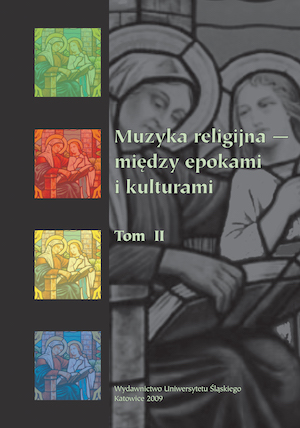Litanie ostrobramskie Stanisława Moniuszki — utwory zapomniane?
Litanie ostrobramskie by Stanisław Moniuszko — forgotten works?
Author(s): Magdalena Chrenkoff
Subject(s): Music
Published by: Wydawnictwo Uniwersytetu Śląskiego
Summary/Abstract: Church music constituted a separate though important trend for Stanisław Moniuszkocontinued throughout his whole in his works. Litanie ostrobramskie, considered to be themost outstanding religious works Moniuszko created, appeared in the so called “Vilnius period”(1840—1858). Litania ostrobramska do Najświętszej Marii Panny, often performed in thesanctuary in Vilnius, was worked out by Moniuszko four times (I F-dur, 1843; II F-dur, 1849;III e-moll, before 1854, IV C-dur, 1855), giving it an artistic setting in the form ofmulti-partial works on solo voices and mixed choir accompanied with a full symphonic orchestra.The usage of litany imposes, to a certain extent, the way of its musical interpretation,i. e. it begins and ends with the phrases from the mass (Kyrie eleison — Christe audi nosand Agnus Dei) suggests a symmetric perspective of a music presentation, its subsequentcalls and repetitive phrase of ora pro nobis in the main part of the litany demand an antiphonalperspective somehow rewritten into voices, and the nature of prayer indicated the type ofmusical expression. The composer, to diversify a monotonous repetition of a supplicative refrain(miserere nobis, ora pro nobis) changed the nature of a musical interpretation, as well asa disposition of voices, and, additionally, gave the instruments individual parts avoiding“solo shows”.Nowadays, Stanisław Moniuszko is known, first of all, for his operas and songs. His religiousmusic remains scarcely known and is rarely performed. Meanwhile, the author paida lot of attention to Litanie ostrobramskie. In his letter to Feliks Zawadzki, Moniuszko confessed:“I love this music more than anything else”.Church music constituted a separate though important trend for Stanisław Moniuszkocontinued throughout his whole in his works. Litanie ostrobramskie, considered to be themost outstanding religious works Moniuszko created, appeared in the so called “Vilnius period”(1840—1858). Litania ostrobramska do Najświętszej Marii Panny, often performed in thesanctuary in Vilnius, was worked out by Moniuszko four times (I F-dur, 1843; II F-dur, 1849;III e-moll, before 1854, IV C-dur, 1855), giving it an artistic setting in the form ofmulti-partial works on solo voices and mixed choir accompanied with a full symphonic orchestra.The usage of litany imposes, to a certain extent, the way of its musical interpretation,i. e. it begins and ends with the phrases from the mass (Kyrie eleison — Christe audi nosand Agnus Dei) suggests a symmetric perspective of a music presentation, its subsequentcalls and repetitive phrase of ora pro nobis in the main part of the litany demand an antiphonalperspective somehow rewritten into voices, and the nature of prayer indicated the type ofmusical expression. The composer, to diversify a monotonous repetition of a supplicative refrain(miserere nobis, ora pro nobis) changed the nature of a musical interpretation, as well asa disposition of voices, and, additionally, gave the instruments individual parts avoiding“solo shows”.Nowadays, Stanisław Moniuszko is known, first of all, for his operas and songs. His religiousmusic remains scarcely known and is rarely performed. Meanwhile, the author paida lot of attention to Litanie ostrobramskie. In his letter to Feliks Zawadzki, Moniuszko confessed:“I love this music more than anything else”.
Book: Muzyka religijna – między epokami i kulturami. T. 2
- Page Range: 71-87
- Page Count: 17
- Publication Year: 2009
- Language: Polish
- Content File-PDF

